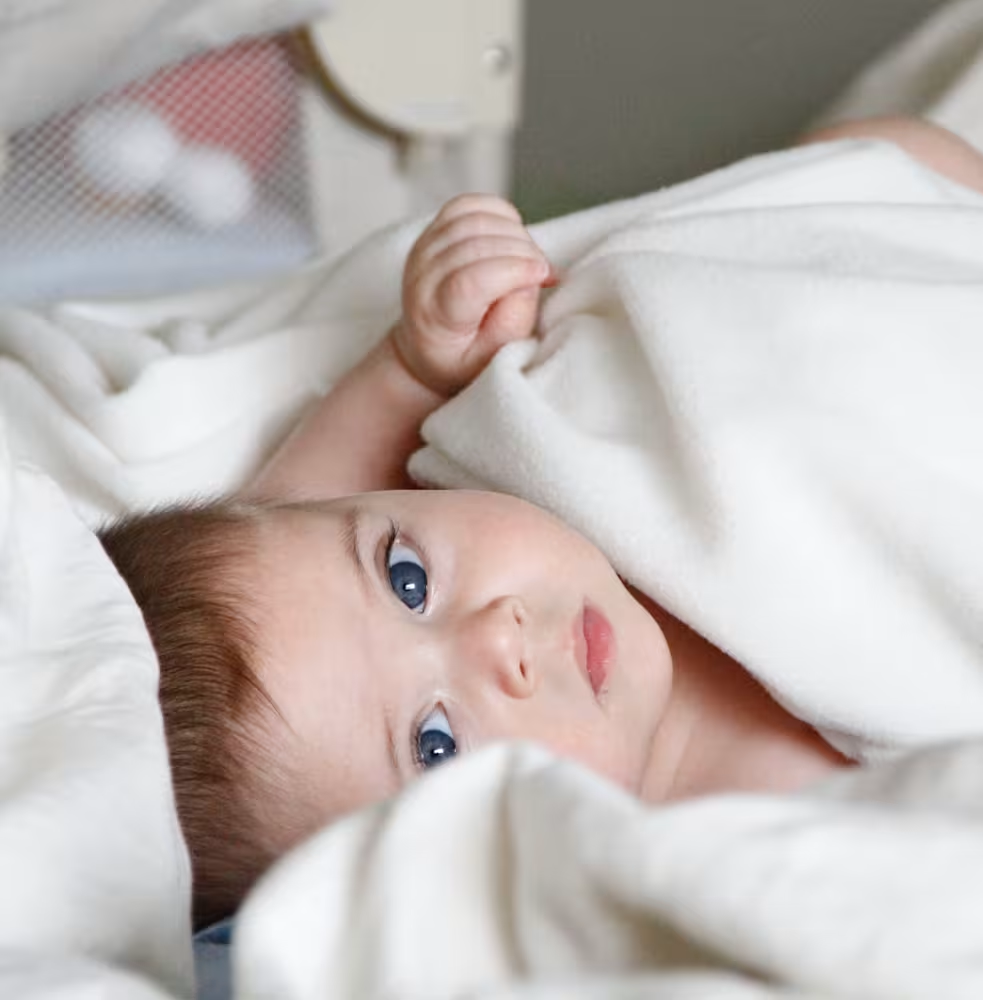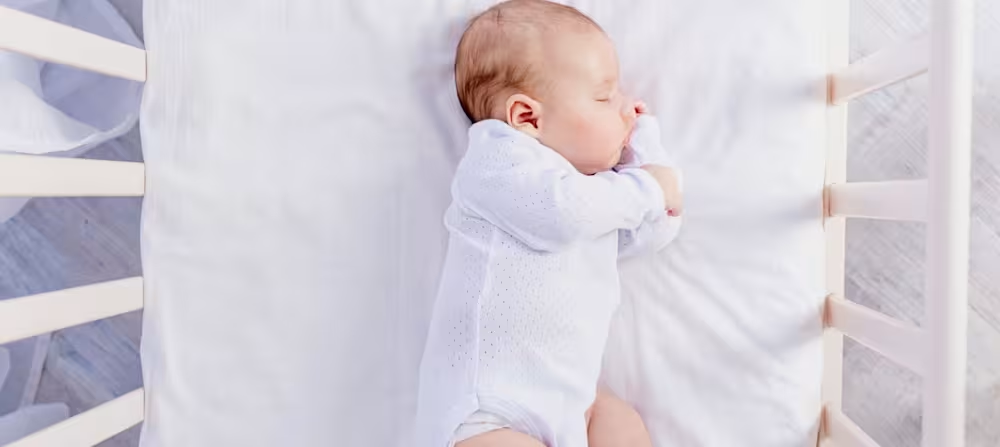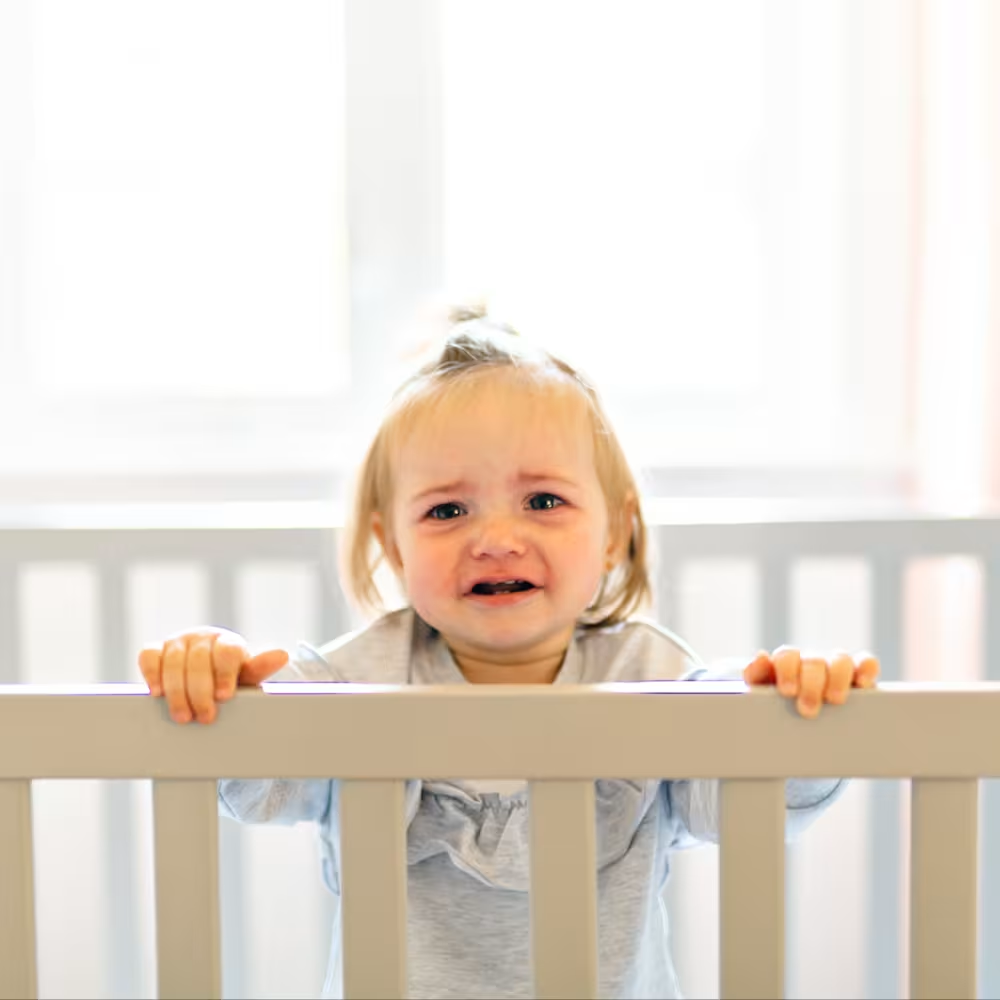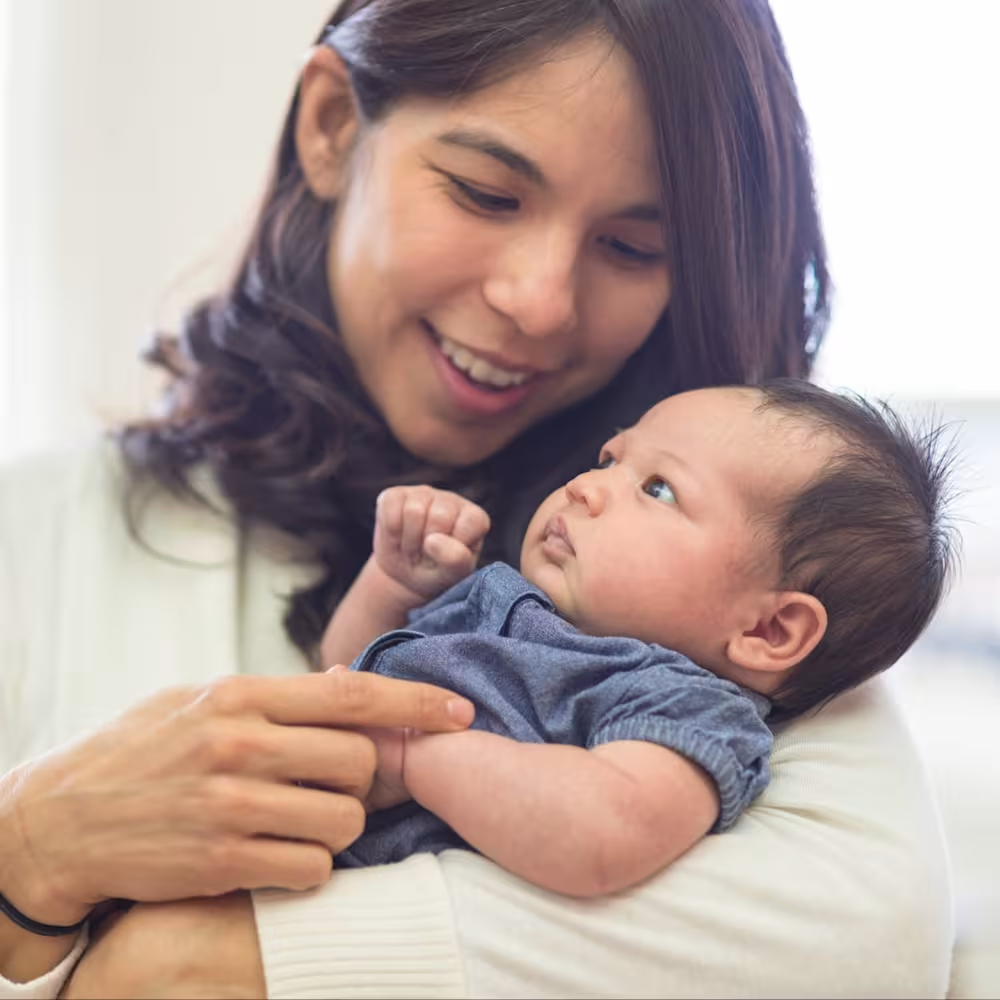Newborn won't sleep unless being held: What to do?
Updated Dec 19, 2025

It’s natural and pretty common for newborns to prefer being held for sleep — there’s nothing like the comfort and warmth of a caregiver. And babies this age aren’t developmentally ready to consistently fall asleep and stay asleep on their own just yet. However, we also understand that holding your baby for the entire duration of their sleep can be exhausting. If you’re looking for a break every now and then, there are some ways you can help set a good sleep foundation for your little one. With time and practice, they’ll get there!
In this article, we’ll walk you through why newborns prefer to be held for sleep, give you tips for setting your baby up for success when it’s age-appropriate, and answer frequently asked questions about babies who don’t want to sleep on their own.
Table of Contents
Why babies sleep only when held
If it seems like your newborn only wants to sleep on your chest, you’re not alone! This is fairly common for young babies for physical and emotional reasons.
Attachment and bonding
Babies, especially in the first months of life, are still getting used to life outside the womb and want to be near their caregivers. Like skin-to-skin, holding your baby close [] promotes parent-child bonding. In the early weeks and months, the close contact helps your baby get used to you — your smell, your touch, and your voice. As your baby grows, they’ll continue to look to you for comfort and care during awake and sleep times.
Temperature and breathing regulation
Newborns have limited ability to regulate their body temperature and can lose heat quickly, nearly four times faster [] than adults. Even in a warm environment, they are not able to control their temperature. Those sleepy snuggles (especially when done skin-to-skin []) have a host of benefits, including temperature regulation and even regulating the baby’s heart rate and breathing.
Is it OK for my baby to sleep on me?
Babies often need help getting to sleep and staying asleep in the newborn phase. It's perfectly natural for your baby to want to sleep on you at this age. Plus, precious snuggles can promote bonding and attachment [], especially in those early months, and lead to better, longer sleep. However, it’s important that your baby sleeps on you safely.
Holding your newborn for sleep is generally regarded as safe, except if there’s a risk that you will also fall asleep with your little one on you. The American Academy of Pediatrics (AAP) warns [] that the risk of sleep-related infant death is up to 67 times higher if your little one falls asleep with someone on a soft surface, such as an armchair or couch.
Many parents find it helpful to “babywear” so that they’re hands-free. Using a sling or another type of carrier may allow you to do some of your normal day-to-day activities while your little one is close to you too. (Just be careful when doing things like bending over or cooking). Babywearing may also lead to less crying from your baby and promote language development [].
Note that the AAP has various recommendations for safe sleep, including []:
If your child falls asleep in a carrier, car seat, stroller, swing, etc., move them to a firm sleep surface as soon as possible
Place your baby on their back for all naps and at night
Make sure there are no soft items (blankets, pillows, toys, etc.) in a baby’s sleep space
Avoid weighted sleep sacks, swaddles, and blankets
Let's chat about contact napping
How to get a newborn to sleep without being held
It’s normal and natural for newborns to need help to fall asleep — and stay asleep — a lot of the time. They don’t have the ability to consistently self-soothe yet! However, at this age, you can start building sleep foundations that can optimize sleep and perhaps give you a break from holding your baby to sleep.
| Strategy | Explanation |
|---|---|
| Set age-appropriate expectations | Babies likely won’t be able to fall asleep on their own consistently until between 4 - 6 months old |
| Try swaddling | Swaddling mimics the comfort of the womb, potentially leading to better sleep |
| Add extra snuggles at bedtime | A good cuddle session can make sure your newborn feels safe and secure before sleep |
| Expose baby to the crib during non-sleep times | Let your newborn “play” in the crib and get used to the space when they’re awake |
| Start with one crib nap per day | Gradually get your baby used to sleeping in their own sleep space |
| Give your newborn regular opportunities to fall asleep on their own | We won’t expect a newborn to master falling asleep independently, however practice may be helpful every so often |
| Increase chances of a successful crib transfer | Try lowering a sleeping baby in the crib without letting their head tip backward. |
| Seek more sleep support | With Huckleberry Premium, our sleep experts can customize a sleep plan for your baby |
Tip #1: Set age-appropriate expectations
It can be helpful to set expectations based on your child’s age when it comes to helping them sleep without being held.
Babies 0 - 3 months
We won’t expect newborns to establish independent sleep habits in these early months. Instead, it’s to need help falling asleep and staying asleep. At this age, babies won’t have predictable sleep schedules yet either – timing and sleep durations typically vary quite a lot early on. Newborn sleep is pretty chaotic!
Babies over 3 months
As your baby nears the 3-month mark, they may be able to make more progress on independent sleep skills, though they likely won’t be able to fully master falling asleep on their own consistently. If you’re ready for your little one to sleep independently at this age, expect progress to be unsteady until closer to .
Tip #2: Try swaddling newborn babies
Newborn babies are still getting used to the outside world! can simulate the womb, which can help soothe little ones and promote better sleep — waking less and sleeping longer. Swaddling also limits the movement of babies’ limbs, which can prevent wake-ups due to the “startle” or Moro reflex [].
While swaddling can be an effective way to help your newborn sleep without being held, it’s important to do so safely. Babies who are swaddled too tightly may develop a problem with their hips. The AAP promotes [] "hip-healthy swaddling," which means the swaddle technique gives the baby's legs room to bend up and out. The AAP [] also recommends that parents discontinue using swaddles once baby starts trying to roll. As soon as your baby shows any signs of rolling, stop swaddling due to the risk of suffocation if they roll onto their stomach.
If your baby loves to sleep like a cute little burrito, transitioning out of the swaddle may be tricky when it comes time. You can find tips for making it a smoother process .
Tip #3: Spend extra time snuggling before sleep times
Adding more cuddles and time for close contact before your baby is due for some shuteye can help ensure they feel comforted and secure at bedtime. Keep in mind this may not mean your baby will then fall asleep and stay asleep on their own in a crib or bassinet afterward, but it may help them drift off to sleep more easily.
Tip #4: Help your little one get accustomed to their sleep space during awake times
Giving your newborn time to “ when they’re awake can help them get acquainted with the space. This may help your baby more willingly go into it for sleep instead of being held. Start small — with just a minute or two — and work up from there if they tolerate it.
Tip #5: Give your newborn regular opportunities to fall asleep on their own
Even though we don’t expect a newborn to establish independent sleep habits quite yet, you can start with . Try placing them in their sleep space when they’re slightly awake once in a while in hopes that they’ll be able to nap there instead of being held.
If your little one wakes up (or doesn’t make it to sleep after 15 - 20 minutes), that’s OK too! This is practice and may take some time. At this point, feel free to call it. Consider holding your baby for this nap to prevent them from getting overtired, which can lead to more trouble falling asleep and staying asleep. You can always try again another time.
Tip #6: Try one crib nap per day
Practice makes perfect. If you’re hoping to get your child to sleep in their own sleep space (instead of on you!), try one crib or bassinet nap per day to get them used to sleeping in this environment. This may look like putting your child in the crib while they’re awake, as we mentioned above, or you might rock or hold them to sleep and then transfer them to the crib. Even if the nap is short, this can give you a break and help get your newborn accustomed to sleeping without being held.
Tip #7: Try transferring a sleeping baby into their sleep space without waking them
If your baby falls asleep on you, try lowering them in the crib without letting their head tip backward. Aim to place the lower half of their body on the mattress first, then gently cradle their head to prevent that feeling of falling that leads to many babies waking up before they settle into the crib. Then sneak out and obsessively check the baby monitor in hopes that they’re still snoozing soundly.
Tip #8: Consider seeking more help
If you’d like more guidance and sleep support for your little one, we can help too! With a subscription to , our sleep consultants can craft a personalized, step-by-step sleep plan for your child.
Evaluate reasons why your child may need extra support temporarily
It’s tough for adults to sleep when they don’t feel well or are uncomfortable, and the same goes for little ones. If it seems like your baby is extra clingy when they’d typically be ready for sleep or wanting to be held for sleep is a new challenge, we recommend evaluating things like:
Are they sick?
Are they uncomfortable or in pain (need to burp, reflux, etc.)?
Are they going through a developmental milestone?
Are they hungry?
Do they need a diaper change?
Are they too warm or cold?
Some of the above factors can be taken care of immediately (hunger, diaper change) while others may take some time to resolve (sickness, developmental milestones). If your newborn needs more support for sleep during these times, that’s OK! You can go back to working on their sleep habits once they’re feeling better.
When to talk to your pediatrician
Consider checking in with your child’s healthcare provider if your newborn:
Seems uncomfortable or in pain during or after feeds (arching, crying, reflux signs).
Has trouble settling or staying asleep even when held, especially if this is a sudden change.
Shows signs of illness, such as fever, congestion, poor feeding, or unusual lethargy.
Isn’t gaining weight well, or is feeding less than expected.
You can also reach out anytime you’re unsure whether your baby’s sleep behavior is typical. Pediatricians hear these questions constantly, and early reassurance helps take pressure off your already-tired brain.
When to stop holding your newborn to sleep?
There’s no right or wrong answer about when you should stop holding your baby to sleep. You can rest assured that you’re not “spoiling” your baby [] or setting them up for future sleep failure if you hold your newborn for sleep as much as you’d like. After all, newborns spend a lot of their time snoozing — often 16 - 17 hours per day []! They aren’t born with and won’t follow a regular 24-hour cycle of eating and sleeping until closer to 3 - 4 months old.
However, around 3 - 4 months of age, babies may begin to wake more often if they have an (like being held or rocked to sleep). Little ones who are used to snuggling for sleep often protest if things change and they’re expected to fall asleep in a crib — of course!
At this age, if you’d like to start setting the foundation for independent sleep, we recommend giving your baby regular opportunities to fall asleep in their crib — even if it’s a bit rocky at first. Doing so will also help them learn to fall back to sleep easier in their own sleep space. Keep in mind that babies aren’t quite developmentally ready to fall asleep on their own consistently until closer to , so progress will likely be up and down for younger babies. This practice will contribute to long-term sleep habits instead of being a quick fix.
Takeaway
It’s normal and developmentally appropriate for newborns to require help falling asleep and staying asleep. At this age, the goal is to set up a good sleep foundation that you can build upon when they’re a little older and able to learn independent sleep habits.
Newborns often prefer to be held for sleep due to physical and emotional reasons, such as parent-child bonding and temperature and breathing regulation.
Some ways you can get your newborn to sleep without being held include using swaddles, giving your baby time to “play” in their sleep space, and trying one crib nap per day.
There’s no magic age where you should stop holding your little one to sleep, as long as you are doing so safely. However, it is often easier for children to establish independent sleep skills later on if you begin giving them regular opportunities to sleep on their own after 3 - 4 months.
Baby won't sleep unless held FAQs
Share article:
Note: The content on this site is for informational purposes only and should not replace medical advice from your doctor, pediatrician, or medical professional. If you have questions or concerns, you should contact a medical professional.
11 Sources
Table of Contents
Share article:






